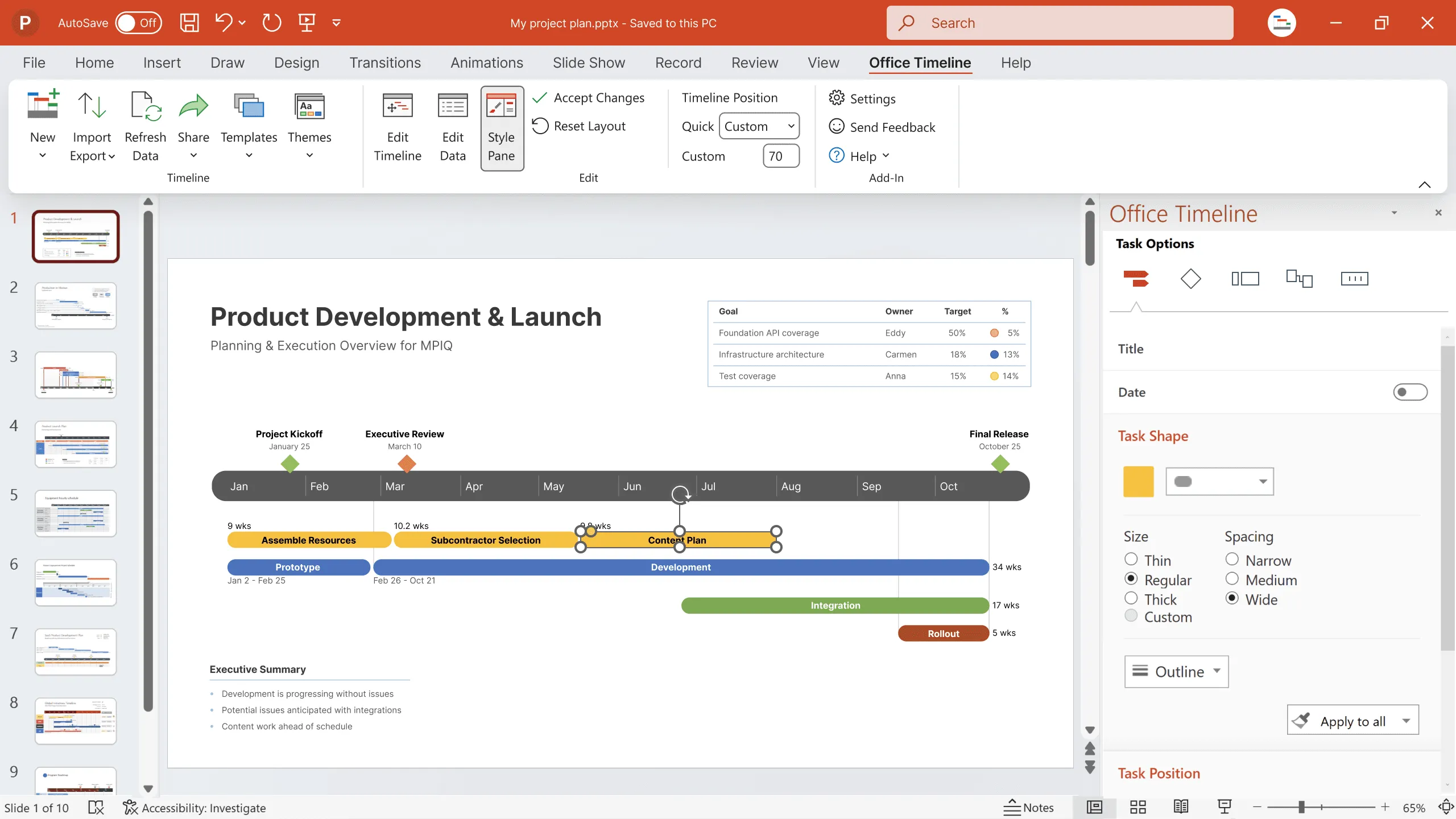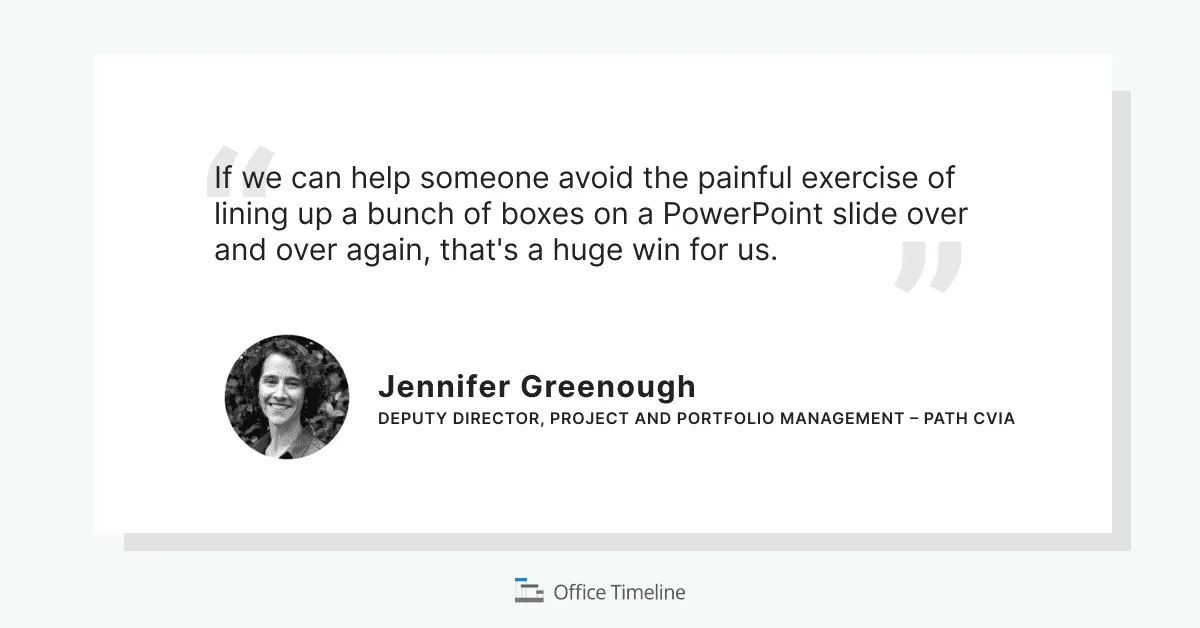Benefits of using simple timelines in project presentations [Case study]
Discover how a medical NGO harnessed the full potential of Office Timeline to drive productivity, enhance collaboration, and deliver exceptional results.

In today’s fast-paced project management landscape, effective communication is the cornerstone of success. As project managers, we often find ourselves grappling with complex, multi-year exercises that demand a nuanced approach to sharing information and progress tracking.
In this blog post, we delve into the real-world challenges faced by Jennifer Greenough, Deputy Director of PPM (Project and Portfolio Management) for PATH Essential Medicine CVIA, as she sought to streamline communication, reduce complexity, and standardize reporting for their intricate projects.
Join us on this journey to discover the vital role of communication in project management and how a timeline generator like Office Timeline emerged as a game-changer in addressing these challenges for CVIA.
Communication in project management
Andrew Grove, the 3rd CEO of Intel and an engineer by trade, once said: “How well we communicate is not determined by how well we say things, but how well we are understood.” This makes perfect sense, especially if you already view communication as an exchange of information between participants, rather than the impersonal delivery of a data stream.
Effective speakers, for instance, understand the importance of adapting their discourse to the audience and utilizing multiple additional venues (graphics, charts, statistics, etc.) to get their point across.
However, when you’re dealing with complex projects that span multiple years, like in the case of PATH Essential Medicine CVIA’s division, communication can become extremely challenging. To put things into context, PATH is a global organization founded in 1977 to advise and partner with public institutions, businesses, grassroots groups, and investors to solve the world’s most pressing health issues.
The CVIA program works in partnership with communities, national health ministries, donors, international organizations, vaccine manufacturers and others to design and develop vaccines that are safe, effective and affordable for the communities that need them most.
Challenges for PATH-CVIA
Here are the most important challenges identified by Deputy Director of PPM (Project and Portfolio Management) Jennifer Greenough in the case study done in collaboration with PATH-CVIA:
1. Tracking complex and multifaceted projects across several years
Before the PPM department was established, project tracking within the CVIA was handled in a very liberal manner. Microsoft Office tools like Excel and PowerPoint were among the most commonly employed tools, and no two spreadsheets or decks looked alike.
This made it extremely difficult to collate data, considering the tangled nature of timelines in long-term projects. Data sharing outside immediate teams was also extremely problematic.
2. Presenting high level summaries and overviews to stakeholders
The absence of a functional means to standardize the reports in addition to using unintuitive, spreadsheet-based tools also meant that presenting their progress to stakeholders and decision-makers was extremely difficult.
According to Greenough, highly granular information is hard to absorb for people who aren’t on the same level as the technical teams. Executives rarely have the time, knowledge or patience to look at exorbitant amounts of details.
3. Standardizing the tracking and reporting tools used across various projects
Greenough also noticed that it was virtually impossible to correctly capture and summarize the work of teams when each report was differently formatted. Either the teams spent hours trying to create reports that adhered to the standards in Excel and PowerPoint, or their design varied wildly.
The issue was further exacerbated by the extensive length of some projects, where team composition was fluid.
Key takeaway
To successfully manage multi-year projects crossing over ten functional areas, Jennifer Greenough was looking for a way to standardize reporting, facilitate communication and decrease complexity.
Let’s now examine how important complexity really is in project management.
A brief introduction to project complexity
Before we progress any further, let’s take a moment to understand what project complexity is. A 2016 study by Franck Marle and Ludovic‐Alexandre Vidal (Managing Complex, High Risk Projects – A Guide to Basic and Advanced Project Management) defines the concept as the property of a project that makes it hard to comprehend, predict and control, in spite of having a reasonable amount of information about the system.
There are two broad categories of complexity:
- Structural – resulting from a project having multiple interdependent components;
- Dynamic – resulted from emerging phenomena like ambiguity, confusion, uncertainty, etc.
Projects can be categorized based on how intricate they are:
- Simple (few or no unknowns, stable, clear cause and effect);
- Complicated (some unknowns, can be deconstructed into simpler problems);
- Complex (multiple unknowns, patterns can be uncovered but aren’t immediately obvious);
- Really complex (multiple unknowns, no discernible patterns even in hindsight, chaotic).
Note: The PATH CVIA program featured in our case study falls under the third category, complex.
Key factors adding to project complexity
In this section, we will examine the results from a 2022 paper published in Systems, which focuses on two major IT project-based companies in Iran. The reason for selecting the two case studies in this article is the resemblance to our PATH CVIA program in terms of challenges and level of complexity.
IT and pharmaceutics are two fields where technological advancements, growing demand, and steep competition (brought about by the 4th industrial revolution wave) have been adding extra layers of complexity over the years.
The paper identifies several broad points of contention, but we will select only the ones relevant to our discussion:
- Stakeholder diversity and conflicting project goals;
- The use of recent and yet unfamiliar technologies;
- Ambiguity and uncertainness of objectives.
With regards to the factors that create these challenges, this study reveals lack of trust (between stakeholders and teams) as the number one cause of complexity, followed by insufficient knowledge (both for the clients and execution teams), and project interdependencies, which are particularly challenging for conservative PM environments.
Note: Similar factors were present in the PATH CVIA case study. The knowledge gap between stakeholders and execution teams with the new vaccine technology development, interspersed with problematic data sharing had led to confusion and objective uncertainty.
The highlighted leverage points that can be used to decrease project complexity are transparency, shared knowledge and mutual trust. What do they all have in common? All three can be addressed by improving communication venues.
Impact of communication in project performance
Let’s now look at a 2019 study from the International Journal of Mechanical Engineering and Technology (IJMET) and published by IAEME. This paper examines how collaborative-style communication affected performance of construction projects in Indonesia, a country where this industry is experiencing an unprecedented growth.
Here is how the author define the working concepts:
- Communication: a pipeline for the flow of information in a two-way transactional process, or a cyclical process in which participants share data;
- Collaboration: effective integration of multiple interdependent actors using formal and informal industry practices;
- Performance: normally dependent on the familiar triumvirate of cost, time and quality, the authors define it as the level at which the stakeholders’ expectations in a project have been met.
Without going into too many details, the paper highlighted a direct positive correlation between:
- Formal communication and collaboration;
- The participants’ willingness to communicate and collaboration;
- Collaboration and project performance.
These findings suggest that an optimal communication framework is the keystone of effective project management. Stakeholders and executives should therefore work towards engendering mutually beneficial relationships protocols, by creating a standardized environment where the information can flow freely between all involved parties.
Case study: PATH CVIA and Office Timeline
Let’s go back to the original challenges identified by Jennifer Greenough as Deputy Director of the PPM department at PATH CVIA:
- Tracking complex and multifaceted projects across several years;
- Presenting high level summaries and overviews to stakeholders;
- Standardizing the tracking and reporting tools used across various projects.
The red thread that runs through these challenges is the need to improve the communication of data and facilitate collaboration between departments, team members, managers and stakeholders.
As we’ve seen in the studies presented earlier, communication and collaboration are two critical factors directly linked to project complexity and performance.
The CVIA’s adoption of Office Timeline has been a success on both of these fronts:
Reducing complexity
- Office Timeline is an add-in that seamlessly integrated within PowerPoint, a software already used by PATH CVIA;
- Data could be imported directly into the add-in from the Excel cloud-based work management system already in place;
- The visual nature of the timelines, Gantt charts, roadmaps and swimlane diagrams facilitated communication of project milestones to execs, stakeholders and peers;
- Using the many available templates allowed creating amazing looking project visuals without fiddling for hours with the design.
- Changes to data no longer implied redesigning the graphic altogether; with Office Timeline’s Refresh Data feature, updates to the graphic can be made automatically.
Improving performance
- Less time spent designing presentations for stakeholders gave researchers more time to focus on their work and boosted productivity;
- The organization is moving toward “speaking the same language”, which will facilitate data sharing and collaboration.
In Jennifer Greenough’s words, “If we can help someone avoid the painful exercise of lining up a bunch of boxes on a PowerPoint slide over and over again, that’s a huge win for us.” And if there’s one thing Office Timeline excels at, this is it.
Tips on how to address tracking and communication challenges
The difficulty of maintaining transparency and tracking performance is directly proportional to the size and complexity of an enterprise. Interdepartmental communication is crucial for a healthy company culture, particularly when there are multiple projects with shared objectives.
Here are a few tips you can employ to ensure that everyone is on the same page and collaborating efficiently to bring about the best outcomes.
1. Sharing KPI reports on a regular basis
Compiling and sharing KPI (Key Performance Indicator) outlines with all involved parties ensures that team members and stakeholders are aligned on all initiatives. It also acts as an incentive to move forwards with a growth mindset, while identifying problematic areas.
2. Documenting critical directives
The goal here is to ensure that teams aren’t spending more time understanding the tasks than they are effectively working on them. However, there is a fine line between documenting the instructions and micro-managing every single step, as the latter tends to create top-down management environments with little room for proactivity and critical thinking.
3. Using the correct PM tools
Not every PM tool or platform is suitable in all scenarios. Relying on too many tools and processes (that were originally designed to simplify tracking, reporting and communication) will just complicate things even further, causing stress, confusion and disarray.
4. Encouraging everyone to speak up
Top insight rarely comes from one manager sitting in their office and thinking really hard about things; rather, it is the organic result of everyone sharing their ideas, challenges, and questions in a safe environment. To achieve this, managers often need to take a step back and allow team members to chip in. Incentivizing transparency and collaboration is a great way to get the ball rolling in the right direction, until these practices become a habit.
5. Holding meetings (the right way)
The transition to online meetings as part of the post-pandemic WFM trend has skyrocketed over the last couple of years. As a result, a number of existing online collaboration platforms as well as many newly developed ones are bringing new features to the table to facilitate transparency, planning, and data sharing. Take advantage of them and back up your reports with visuals, graphics and anything that supports your insights to ensure you’ve captured everyone’s attention.
Conclusion
Reducing complexity is a major communication trend in 2023 and onward. As we’ve seen so far, complexity is a major characteristic of today’s increasingly interconnected business world. Each decision can trigger a cascade of effects downstream, and communication is the key to ensuring that projects can stay on track.
We are currently witnessing efforts to reduce this complexity through a number of solutions aimed at standardizing the means of internal and external communications. With a conscientious approach to topic architecture and a centralized framework, its negative impact can be mitigated.
Project management tips and tricks
Turn project data into professional timelines
Get the advanced features of Office Timeline free for 14 days.



